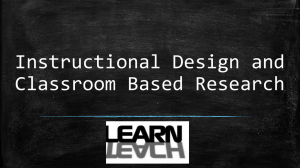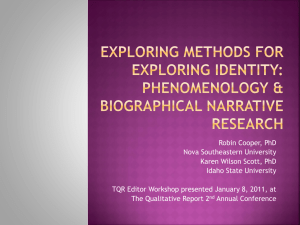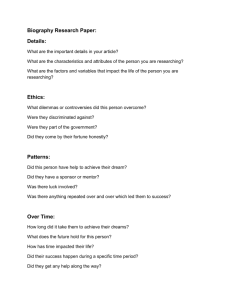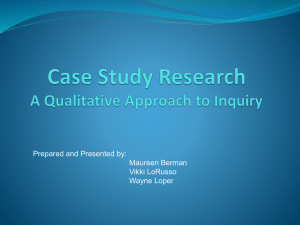Assignment 1 - Teaching - Learning
advertisement
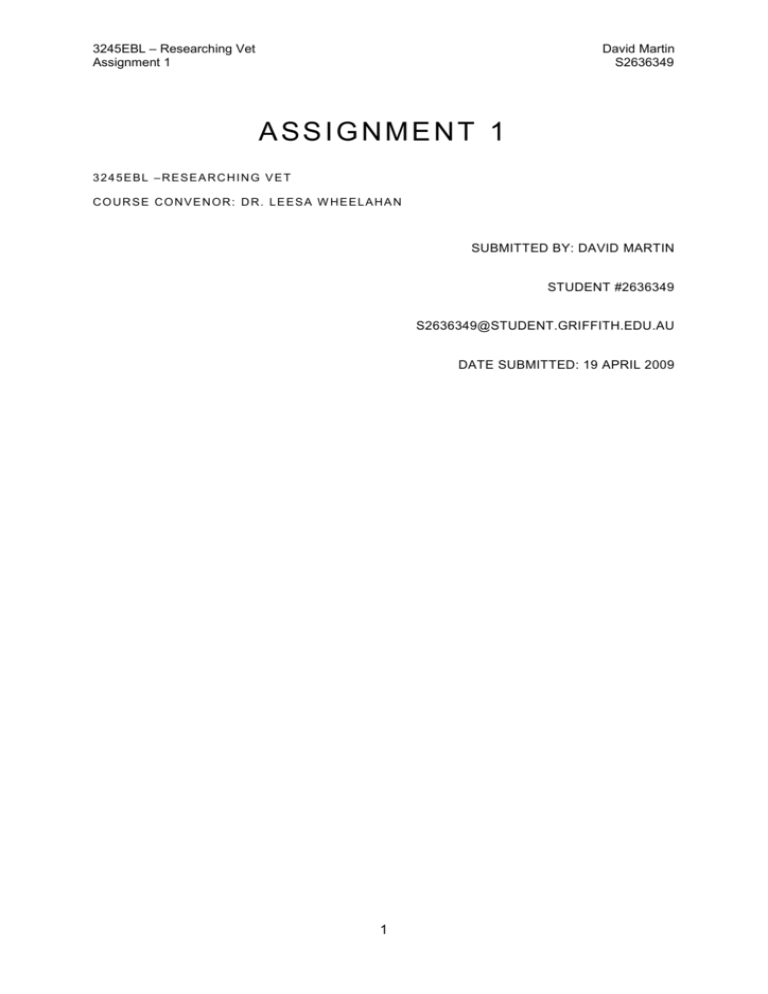
3245EBL – Researching Vet Assignment 1 David Martin S2636349 ASSIGNMENT 1 3245EBL –RESEARCHING VET COURSE CONVENOR: DR. LEESA W HEELAHAN SUBMITTED BY: DAVID MARTIN STUDENT #2636349 S2636349@STUDENT.GRIFFITH.EDU.AU DATE SUBMITTED: 19 APRIL 2009 1 3245EBL – Researching Vet Assignment 1 David Martin S2636349 Educational research can be broadly split into two types, quantitative and qualitative. This assignment will explain and discuss key features of each type of research. The key features of each of type of research will be identified and then validity and reliability of two research papers will be analysed to demonstrate and differentiate between qualitative and quantitative research. The concepts of validity and reliability in research will be identified and the papers examined for these attributes. Creswell’s six steps of research will be used to compare and contrast the two types of research and how the steps are specifically applied to the two research papers. The 2003 conference paper “Understanding participation in learning for non-traditional adult learners: Learning careers and the construction of learning identities” by Crossan, Field, Gallacher and Merrill will be used to exemplify qualitative research methods. The article will be shown to be a valid example of qualitative research, in that it uses on-site interviews and situational analyses. The article will be shown as an example of rigorous, valid and reliable research. To exemplify quantitative research, “The effect of student loan schemes on students returning to study”, a 2008 article by Tumen & Shulruf and Shulruf will be used. This article will also be examined for insights into this type of research and will be argued to what extent the article is an example of rigorous, valid and reliable research. It will be argued that both qualitative and quantitative research can be useful in vocational education research if used appropriately. It is important to evaluate the worthiness, value, relevance and applicability of educational research as a teacher and several methods of doing this will be identified and used in this paper. Key features of valid and reliable research Research is a step by step process that is used to collect and analyse information. Educational research is part of epistemology, which refers to enquiries that distinguish 2 3245EBL – Researching Vet Assignment 1 David Martin S2636349 knowledge from belief (Benton & Craib, 2001, p. 181). All research aims to be important, but proves to be so by adding to existing knowledge, suggesting improvements for practice and informing policy debate (Creswell, 2008, p. 6). Others support the idea that research in education is used to inform, support or obstruct policy (Freebody, 2003, p. 20) which furthers the notion that research must be critically viewed and analysed. Classifying the type of research involved is the first step. Quantative research can be identified by several key features. It takes a scientific approach and uses numbers and measurements. As the Tumen & Shulruf & Shulruf paper shows quantative studies involve the measurement of variables, numerical comparisons, calulcations and statistics that are used to describe patterns within those variables (Spratt, 2003, p. 243). Creswell (2008, p.51) also describes quantative researsh as the addressing of problems that require a description of trends, or explains relationships between variables. The Tumen & Shulruf & Shulruf paper compares a range of variables (p. 404) and identifies the problem as describing the likelihood of former students returning to tertiary study. Quantitative research has historically been seen as reliable because it uses well established scientific methods associated with research and historically, has been the dominate form of education research (Ary, Jacobs, Razavieh, & Sorensen, 2006, p. 25) and it is argued that “a strong empirical approach characterises educational research.” (Wirsma & G, 2005, p. 3). Due to the complexity of the subjects and the difficulties in observing and replicating the actions of people, research in social studies has moved towards using more than this just quantitative research (Ary, Jacobs, Razavieh, & Sorensen, 2006, pp. 16-17). Qualitative research uses different types and amounts of data, involving observations in actual settings, collection and analysis of conversations or questionnaires. Creswell (2005, p. 181) argues that it “takes place in the natural setting” and often uses a narrative report that provides an understanding of the social reality studied (Ary, Jacobs, Razavieh, & Sorensen, 2006, p. 32). The Crossan et al. (2003) paper demonstrates both of these features through use of 70 initial interviews in real life settings and then using narratives to explain the findings. 3 3245EBL – Researching Vet Assignment 1 David Martin S2636349 Qualitative research often addresses problems that have little known about them or provides a detailed understanding of a central observable fact (Creswell, 2008, p. 51). In the Crossan paper it is intended to heuristically “explore the usefulness of our modified concept of a learning career” only addresses the little known problem. It does not intend to provide detailed or typical results and conclusions. Research needs to be valid; it needs to research what it says it is researching. Research must also be reliable; the methods used must produce the same result in similar circumstances every time. Quantitative research depends on its precise measurements to provide reliability and validity. Cresswell (2003, p. 171) argues that there are internal and external threats to validity. Internal problems can include changing procedures or changing of participants during the research. An example of an external problem would be inadequate definitions and measurement of variables. To provide validity qualitative research first requires a researcher who has good observational skills, with the necessary competence and thoroughness (Spratt, 2003, p. 239). While qualitative research is not based on rigid procedures, there are still set strategies used to with the data, which is often collected and analysed at the same time (Burgess, 1985, p. 9). As demonstrated by the two papers here, while qualitative research is often seen as the opposite to quantitative and the setting and types of problems addressed are different the same basic steps apply to both. These steps can be used to further analyse the validity and explain the features of the research papers. Creswell’s Six Steps Creswell (2008) initially outlines the three basic steps as firstly, posing a question, secondly collecting data to answer the question and finally presenting an answer to the question. These are further broken down into six steps. 4 3245EBL – Researching Vet Assignment 1 David Martin S2636349 1. Identifying the problem, 2. Reviewing the literature, 3. Specifying a purpose 4. Collecting the data 5. Analysing & interpreting the data 6. Reporting and evaluating the research There are variations on these steps but all are along the same lines. For example Ary et al. (2008, p. 34) represent them as seven steps; selecting a problem, reviewing the literature, designing the research, collecting the data, analysing the data, interpreting findings/stating conclusions and reporting results. Creswell’s six steps will be used to analyse the two papers. 1. Identify the Problem The first step in the research process is identifying the research topic, research problem, purpose of the research and the research questions (Creswell, 2008, p. 8). Important research problems can come from experience, theoretical deduction and related literature (Ary, Jacobs, Razavieh, & Sorensen, 2006, p. 46). It is argued that the problem should be researched if it fills a gap in existing literature, uses different participant or sites to previous studies, extends or is more thorough than past research, give voice to underrepresented groups or if it directly informs practice (Creswell, 2008, pp. 72-73). The Crossan et al. (2003 p. 57) paper specifically plans to build on existing perspectives of previous studies. The Tumen & Shulruf (2003, p.) paper identifies the broad problem being researched in the introduction, using the sentence starting with “This paper aims to”. Another part of identifying the problem is to specify the indented audience (Creswell, 2008, p. 79), which the Tumen & Shulruf paper (2008, p. 403) does, stating that policy makers will 5 3245EBL – Researching Vet Assignment 1 David Martin S2636349 be able to use the provided tools for forecasting and modelling. While the Crossan et al. (2003) paper does not specify an intended audience in their introductory section or conclusion the paper but does refer to policy pressures (p. 56) and institutional procedures (p. 58). The intended audience could be the people who make those decisions. 2. Reviewing the Literature Both types of research use literature as part of research to provide justification for the research problem. The steps involve locating primary (actual research and papers) and secondary (reviews or summaries of publications) literature, critically evaluating and selecting literature and the writing of a literature review (Creswell, 2008, pp. 89-113). The Tumen & Shulruf (2008, pp. 402-403) theoretical background section uses prior studies, while the methods section (pp. 403-404) identifies the primary research being used. The Crossan (2003, pp. 55-58) uses reference to secondary research papers from the introduction and explains the primary research in the methodology section (pp. 58-59). The role that the literature review plays is different for each type of research. In quantative research it plays a major role, really specifying the need for the study, while in qualitative research it plays a more minor role initially, but can be used progressively to clarify and interpret results as they are received and to interpret the significance of these results (Ary, Jacobs, Razavieh, & Sorensen, 2006, pp. 70-71). Neither of the papers includes a literature review section, but instead uses references to other research methodology, results and publications in their introduction and theoretical background. The literature review performs the function of validating the basis of the research and assists in the next step of the research process. 3. Specifying the purpose 6 3245EBL – Researching Vet Assignment 1 David Martin S2636349 In this step the research problem that was identified earlier is refined. With the assistance of the literature review the central ideas of the research study can be posed as specific questions, narrowing down the research problems. This is more often the case with quantitative research, which uses a narrow purpose with measurable and observable data (Creswell, 2008, p. 52). The Tumen & Shulruf (2008, p. 401) paper does this explicitly at the end of the introduction using the statement starting with “This study addresses the question of ....” giving the research paper a clearly defined purpose. Qualitative research papers do not normally define a specific question but provides a broad purpose (Creswell, 2008, p. 52), The Crossan et al. (2003, p. 56) paper provides this by writing “This paper explores the experiences ....” and not seeking an exact outcome but instead developing a framework of understanding. 4. Collecting data This step is performed very differently in the two types of research because the types of information and the methods used to obtain the data are related and need to be relevant to the central purpose of the research (Burgess, 1985, p. 3). Quantitative uses predetermined instruments that provide numeric data from a large number of individuals (Creswell, 2008, p. 52) which are described as part of the methodology. The Tumen & Shulruf (2008, p. 404) paper lists and explains the variables as a way of defining the predetermined instruments. The paper clearly defines the population sample as “by expanding the populations studied to include all domestic tertiary students who participated in tertiary education in New Zealand from 1997 to 2003 and had the chance to return by the end of 2005”. The paper clearly identifies the variables that are included in the model, both the dependant variable of pathway choice and the range of independent variables. The focus of qualitative research is on general or emerging data in the text of images from a small number of individuals or sites (Creswell, 2008, p. 52). The Crossan et al. paper (2003, 7 3245EBL – Researching Vet Assignment 1 David Martin S2636349 p. 58) initially draws on 70 interviews, but then presents two as narratives demonstrating use of a small number of individuals. Another commonly found feature is that the data collection is done on-site, in the situation that is the focus of the research. In this situation it is important to identify, select and obtain permission from individuals to study them, before asking questions or observing behaviours (Creswell, 2008, p. 10). There are several current carbon reduction schemes in Queensland (Queensland Government, 2007): The Solar Hot Water Rebate Scheme Minimum sustainable design measures in place since 2006 5. Analysing and interpreting data The focus of this step in a quantitative research project is for the use of statistical analysis that describes trends, comparisons between groups or relationships between the variables. (Creswell, 2008, p. 52). The results section of the Tumen & Shulruf (2008) report gives detailed statistical comparisons including charts and explanations of these comparisons, groupings and measurements of the variables. This supports Creswell (2008, p. 10) in his statement that individual responses are determined and summarised, often using tables, figures and charts. Qualitative research can use text analysis, descriptions and thematic developments to give large meaning of the findings (Creswell, 2008, p. 52). The Crossan et al. (2003, pp. 59-64) paper uses descriptions and thematic developments in the form of two separate narratives and uses the Discussion section (pp. 64-65) to provide an interpretation. 6. Reporting and evaluation 8 3245EBL – Researching Vet Assignment 1 David Martin S2636349 In this step of the research project, conclusions and explanations are used to answer the research questions (Creswell, 2008, p. 10). While both of the papers do this, they use different headings to differentiate this step as well as having a different overall purpose to the reporting and evaluation step. The Crossan et al. (2003, pp. 65-66) paper uses a conclusion section to summarise the emergent model. This conforms to the idea that finding in qualitative research is presented in a narrative form, emphasising the credibility of the findings (Ary, Jacobs, Razavieh, & Sorensen, 2006, p. 86) which is further supported by Creswell (2008, p. 52) who argues that qualitative reporting is flexible, emergent and is reflective and biased. The paper demonstrates bias and reflection with statements like “We do not think so” (p, 65), “While we share....” and “Our approach to the concept....” (p. 66). However qualitative research uses standard fixed structures using an objective and unbiased approach (Creswell, 2008, p. 58). The Tumen & Shulruf (2008, pp. 409-411) paper uses a discussion section to report the results of the research. It reiterates the variables and how the analysis confirms the initial hypotheses of the research. Conclusions Both types of research discussed in this paper can be valid and useful for adult and vocational education. It is important to be able to contribute and critically analyse research. In this way, teachers (as researchers) can inform and debate policy and improve practice. Quantative research requires a specific purpose and the measurement of variables, access to large populations of participants and statistical interpretation to confirm or expand hypotheses. Qualitative research can be much broader in its purpose and often uses smaller populations but ones that are situated in real life settings where little is known about the problem being researched. 9 3245EBL – Researching Vet Assignment 1 David Martin S2636349 The validity and reliability of research can be analysed by using Creswell’s six steps. While these steps represent a solid and proven model of research, the two types of research approach the steps differently. Research can be considered valuable to vocational and adult education if it is able to firstly identify the problem being researched and confirm that the research will fill a gap in existing knowledge or advance existing theories. A successful literature review will identify valid and reliable sources of previous and related studies, giving evidence of the value of the new research. Both of these steps lead to the research having a specific purpose, which is the third step used in Creswell’s model. The collection of data is performed differently for each type of research, but needs the methods used need to be checked for consistency and reliability. The methods used to analyse or interpret of the data, either comparing the variables of the quantative research or describing the thematic developments in the qualitative research are important and must be examined for inaccuracies or misinterpretation. The reporting and evaluation step of the research provides the conclusions, explanations or answers to the research problem initially stated in earlier steps and is unbiased and objective in quantitative research whereas qualitative research is reflective. If a research paper has been identified as following these, or similar steps; identifies a worthy problem, uses valid and rigorous data collection and analysis methods and provides considered and balanced conclusions it can be considered good research that can assist the education field by informing policy or improving practice. 10 3245EBL – Researching Vet Assignment 1 David Martin S2636349 References Ary, D., Jacobs, L. C., Razavieh, A., & Sorensen, C. (2006). Introduction to Research in Education (7th Ed. ed.). Belmont: Thomson Wadsworth. Benton, T., & Craib, I. (2001). Philosophy of social science: the philosophical foundations of social thought. New York: Palgrave. Burgess, R. G. (1985). Strategies of educational research. London: The Falmer Press. Creswell, J. W. (2008). Education research: Conducting and evaluating quantitaive and qualitative research (3rd ed. ed.). New Jersey: Pearson. Freebody, P. (2003). Qualitative research in education: interaction and practice. London: SAGE Publications. Spratt, P. (2003). Social research methods. In R. Jureindini, & M. Poole (Eds.), Sociology: Australian connections. Crows Nest: Allen & Unwin. Tumen, S., & Shulruf, B. (2008). The effect of student loan schemes on students returning to study. Journal of Higher Education Policy and Management , 4 (30), 401-414. Wirsma, W., & G, J. S. (2005). Educational research: its nature and characteristics. In Research methods in education: an introduction (8th ed., pp. 1-27). Boston: Pearson. 11
